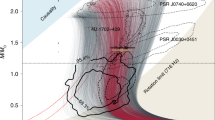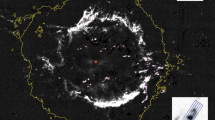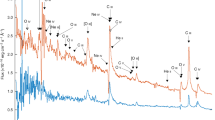Abstract
The surface of hot neutron stars is covered by a thin atmosphere. If there is accretion after neutron-star formation, the atmosphere could be composed of light elements (H or He); if no accretion takes place or if thermonuclear reactions occur after accretion, heavy elements (for example, Fe) are expected. Despite detailed searches, observations have been unable to confirm the atmospheric composition of isolated neutron stars1. Here we report an analysis of archival observations of the compact X-ray source in the centre of the Cassiopeia A supernova remnant. We show that a carbon atmosphere neutron star (with low magnetic field) produces a good fit to the spectrum. Our emission model, in contrast with others2,3,4, implies an emission size consistent with theoretical predictions for the radius of neutron stars. This result suggests that there is nuclear burning in the surface layers5,6 and also identifies the compact source as a very young (∼330-year-old) neutron star.
This is a preview of subscription content, access via your institution
Access options
Subscribe to this journal
Receive 51 print issues and online access
$199.00 per year
only $3.90 per issue
Buy this article
- Purchase on Springer Link
- Instant access to full article PDF
Prices may be subject to local taxes which are calculated during checkout



Similar content being viewed by others
References
Pavlov, G. G., Zavlin, V. E. & Sanwal, D. in Proc. WE-Heraeus Seminar: Neutron Stars, Pulsars and Supernova Remnants (eds Becker, W., Lesch, H., & Trümper, J.) Vol. 270 273–286 (MPE Report 278, MPI, 2002)
Pavlov, G. G., Zavlin, V. E., Aschenbach, B., Trümper, J. & Sanwal, D. The compact central object in Cassiopeia A: a neutron star with hot polar caps or a black hole? Astrophys. J. 531, L53–L56 (2000)
Chakrabarty, D., Pivovaroff, M. J., Hernquist, L. E., Heyl, J. S. & Narayan, R. The central X-ray point source in Cassiopeia A. Astrophys. J. 548, 800–810 (2001)
Pavlov, G. G. & Luna, G. J. M. A dedicated Chandra ACIS observation of the central compact object in the Cassiopeia A supernova remnant. Astrophys. J. 703, 910–921 (2009)
Rosen, L. C. Hydrogen and helium abundances in neutron-star atmospheres. Astrophys. Space Sci. 1, 372–387 (1968)
Chang, P. & Bildsten, L. Evolution of young neutron star envelopes. Astrophys. J. 605, 830–839 (2004)
Reed, J. E., Hester, J. J., Fabian, A. C. & Winkler, P. F. The three-dimensional structure of the Cassiopeia A supernova remnant. I. The spherical shell. Astrophys. J. 440, 706–721 (1995)
Ashworth, W. B. A probable Flamsteed observation of the Cassiopeia A supernova. J. Hist. Astron. 11, 1–9 (1980)
Fesen, R. A. et al. The expansion asymmetry and age of the Cassiopeia A supernova remnant. Astrophys. J. 645, 283–292 (2006)
Tananbaum, H. Cassiopeia A. IAU Circ. 7246, (1999)
Garmire, G. P., Bautz, M. W., Ford, P. G., Nousek, J. A. & Ricker, G. R. Advanced CCD imaging spectrometer (ACIS) instrument on the Chandra X-ray Observatory. Proc. SPIE 4851, 28–44 (2003)
Hwang, U. et al. A million second Chandra view of Cassiopeia A. Astrophys. J. 615, L117–L120 (2004)
Heinke, C. O., Rybicki, G. B., Narayan, R. & Grindlay, J. E. A hydrogen atmosphere spectral model applied to the neutron star X7 in the globular cluster 47 Tucanae. Astrophys. J. 644, 1090–1103 (2006)
Lattimer, J. M. & Prakash, M. Neutron star observations: prognosis for equation of state constraints. Phys. Rep. 442, 109–165 (2007)
Murray, S. S., Ransom, S. M., Juda, M., Hwang, U. & Holt, S. S. Is the compact source at the center of Cassiopeia A pulsed? Astrophys. J. 566, 1039–1044 (2002)
Greenstein, G. & Hartke, G. J. Pulselike character of blackbody radiation from neutron stars. Astrophys. J. 271, 283–293 (1983)
Yakovlev, D. G. & Pethick, C. J. Neutron star cooling. Annu. Rev. Astron. Astrophys. 42, 169–210 (2004)
Page, D., Geppert, U. & Weber, F. The cooling of compact stars. Nucl. Phys. A 777, 497–530 (2006)
Tsuruta, S. et al. Thermal evolution of hyperon-mixed neutron stars. Astrophys. J. 691, 621–632 (2009)
Woosley, S. E., Heger, A. & Weaver, T. A. The evolution and explosion of massive stars. Rev. Mod. Phys. 74, 1015–1071 (2002)
Gotthelf, E. V. & Halpern, J. P. Discovery of a 112 ms X-ray pulsar in Puppis A: further evidence of neutron stars weakly magnetized at birth. Astrophys. J. 695, L35–L39 (2009)
Muslimov, A. & Page, D. Delayed switch-on of pulsars. Astrophys. J. 440, L77–L80 (1995)
Predehl, P., Costantini, E., Hasinger, G. & Tanaka, Y. XMM-Newton observation of the galactic centre—evidence against the X-ray reflection nebulae model? Astron. Nachr. 324, 73–76 (2003)
Davis, J. E. Event pileup in charge-coupled devices. Astrophys. J. 562, 575–582 (2001)
Alcock, C. & Illarionov, A. Surface chemistry of stars. I. Diffusion of heavy ions in white dwarf envelopes. Astrophys. J. 235, 534–540 (1980)
The Opacity Project Team. The Opacity Project 〈http://cdsweb.u-strasbg.fr/topbase/op.html〉 (2009)
Rajagopal, M. & Romani, R. W. Model atmospheres for low-field neutron stars. Astrophys. J. 461, 327–333 (1996)
Zavlin, V. E., Pavlov, G. G. & Shibanov, Yu. A. Model neutron star atmospheres with low magnetic fields. Astron. Astrophys. 315, 141–152 (1996)
Ho, W. C. G. & Lai, D. Atmospheres and spectra of strongly magnetized neutron stars. Mon. Not. R. Astron. Soc. 327, 1081–1096 (2001)
Mori, K. & Ho, W. C. G. Modelling mid-Z element atmospheres for strongly magnetized neutron stars. Mon. Not. R. Astron. Soc. 377, 905–919 (2007)
Acknowledgements
W.C.G.H. thanks N. Badnell, P. Chang, and D. Lai for discussions. W.C.G.H. appreciates the use of the computer facilities at the Kavli Institute for Particle Astrophysics and Cosmology. W.C.G.H. acknowledges support from the Science and Technology Facilities Council (STFC) in the United Kingdom. C.O.H. acknowledges support from the Natural Sciences and Engineering Research Council (NSERC) of Canada.
Author Contributions W.C.G.H. calculated the new models and wrote the manuscript. C.O.H. reduced the data, fitted the models to the data, and contributed to the manuscript.
Author information
Authors and Affiliations
Corresponding authors
Rights and permissions
About this article
Cite this article
Ho, W., Heinke, C. A neutron star with a carbon atmosphere in the Cassiopeia A supernova remnant. Nature 462, 71–73 (2009). https://doi.org/10.1038/nature08525
Received:
Accepted:
Issue Date:
DOI: https://doi.org/10.1038/nature08525
This article is cited by
-
A strangely light neutron star within a supernova remnant
Nature Astronomy (2022)
-
Conceptual design of BabyIAXO, the intermediate stage towards the International Axion Observatory
Journal of High Energy Physics (2021)
-
Analytical model of strange star in low-mass X-ray binary KS 1731-260
Astrophysics and Space Science (2016)
-
Neutron Stars—Thermal Emitters
Space Science Reviews (2015)
Comments
By submitting a comment you agree to abide by our Terms and Community Guidelines. If you find something abusive or that does not comply with our terms or guidelines please flag it as inappropriate.



